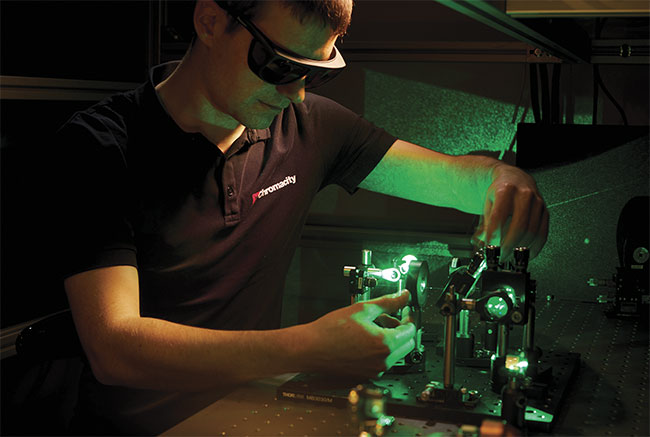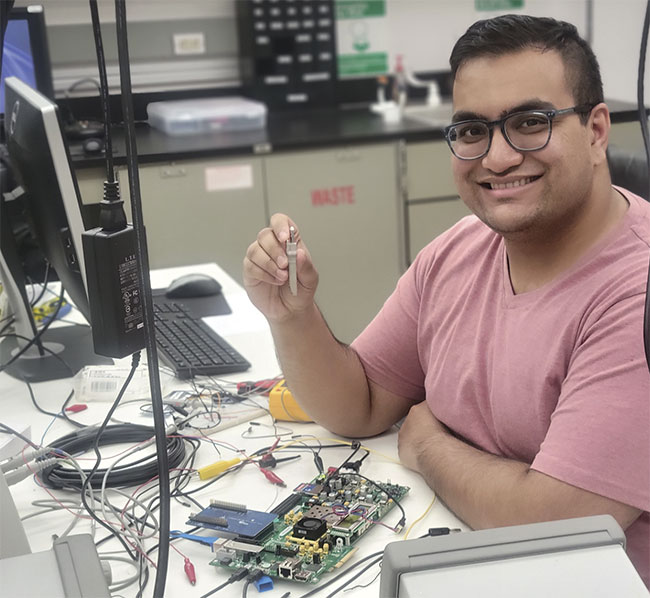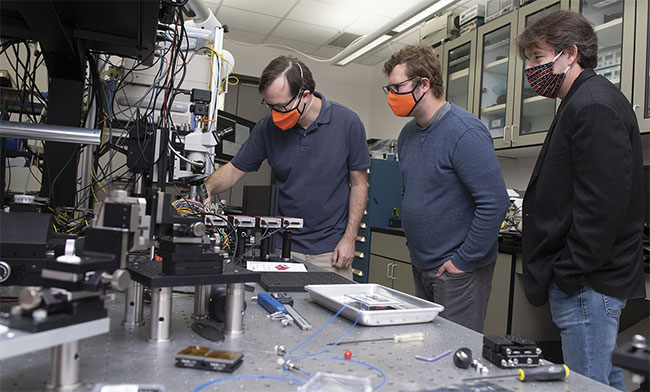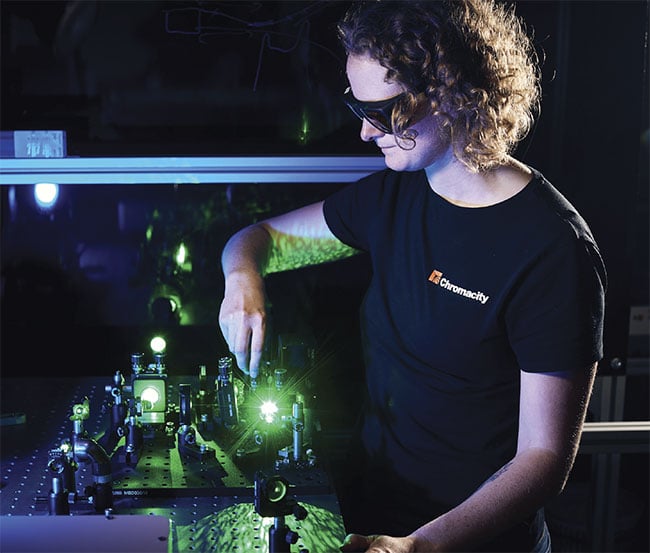Only through collaboration, shared resources, and a constant exchange of talent can industry and academia cultivate basic photonics research into successful new commercial technologies.
MICHAEL EISENSTEIN, SCIENCE WRITER
When Irfan Punekar first began considering where to pursue his degree in computer engineering, he had an important item on his wish list. “I definitely wanted a school where I could get industry experience,”
he said, emphasizing the importance of conducting research with clear real-world applications. He ultimately found his match at the Rochester Institute of Technology (RIT) in upstate New York.
“One of the things I liked about RIT is the co-op system, and the fact that we get to use our skills, even while we’re still studying, to do something that actually matters to someone,” said Punekar, who is now in the process of completing his master’s degree.

Unlike many industries, the photonics sector lost little momentum due to the COVID-19 pandemic, and demand is high for the fresh ideas and new talent that academia is cultivating in its rarified labs. Industry-academia partnerships, internships, and co-op programs are helping to bridge the divide between basic research and commercial application while benefiting stakeholders on both sides. Courtesy of Chromacity.
RIT is just one of several leading photonics research universities that has made engagement with commercial partners a priority, and participants in both industry and academia see a clear opportunity for mutual benefit. Shahida Imani, CEO of Edinburgh, Scotland-based laser manufacturer Chromacity, described a booming photonics industry that has continued to grow despite the hardships inflicted by the pandemic, but which also needs a steady influx of fresh ideas and new talent. “Many technologies are born out of academia, and it’s only when those technologies are validated in academia that you can actually really consider commercializing them,” she said.
On the university side, such interactions can better prepare students and postdocs to pursue their long-term career goals. Patrik Öhberg, head of the Institute of Photonics and Quantum Sciences (IPAQS) at Heriot-Watt University’s Edinburgh campus, estimates that 70% to 80% of the students in his program end up in industry jobs. Different institutions find different frameworks to facilitate the exchange of people and ideas, but all such frameworks are predicated on the notion that much of the academic research now taking place in the photonics world is ripe for commercial development. “We want our ideas to get into the real world as quickly as possible, which is not necessarily the primary directive of academic research all the time,” said Don Figer, director of RIT’s Future Photon Initiative (FPI).
FPI is one of several university research centers designed to coordinate photonics-related research across myriad departments. Similar initiatives include the Karlsruhe School of Optics & Photonics in Germany and the Stanford Photonics Research Center (SPRC) in California.

Irfan Punekar, a doctoral student working with Don Figer at RIT’s Future Photon Initiative, advises students to take chances and make the most of internship and co-op programs because these opportunities in the commercial realm often unveil unexpected directions for their career. Courtesy of Rochester Institute of Technology.
“There are about 50 SPRC faculty on campus covering 11 different departments in three different schools,” said Thomas Baer, the executive director of the center at Stanford University. “And with those 50 or so faculty, there are probably 300 postdocs and students, so it’s a fairly large group involved with SPRC activities.” The nature of the center’s research can range from astrophysics to biomedical imaging to materials science — any field in which optics or photonics technologies play a role.
These research centers also act as facilitators for industry-supported, on-campus research, and they provide opportunities for students to pursue internships, co-op work, and other on-site commercial experience. Baer said his own lengthy career in industry has equipped him to develop collaborative arrangements that work well for both SPRC researchers and potential industry partners. “We don’t do any trade-secret research,” he said. “Anything that gets done on campus that’s funded by industry has to be publishable. We can work with [partners] in terms of developing new technologies that they’re interested in and are supporting and guide them to the Office of Sponsored Research and our technology-licensing capability.”

Informal coordination between industry and academia often leads to more structured partnerships. RIT researchers (from left) Stefan Preble, Gregory Howland, and Edwin Hach spent several years discussing possible projects in the area of quantum optics with scientists at L3Harris. In late 2020, RIT announced it was formalizing the arrangement in a partnership with the company to further advance the technology. Courtesy of A. Sue Weisler/Rochester Institute of Technology
From collaboration to partnership
Such coordination can also help to turn informal collaboration into a productive partnership. For example, RIT researchers Stefan Preble, Edwin Hach, and Gregory Howland spent several years discussing possible projects in the area of quantum optics with Tim Burt, a scientist at technology company L3Harris. Through FPI’s efforts, the relationship became a formal industry collaboration in the fall of 2020, with funding from the company supporting the team’s on-campus research. “We have a shared space where we work together,” Preble said. “They get access to work with our teams here and come to our labs and meeting rooms and such.”
RIT’s Figer said FPI has arranged several such team-ups through its Industry Partnership Program, including a multiyear collaboration with Rochester-based Precision Optical Transceivers. SPRC similarly allows its laboratories to host researchers from companies such as Hamamatsu through a fee-based visiting scholar program.
Independent of the photonics research center model, a number of other universities are engaged in forming one-on-one strategic partnerships with photonics companies. For example, Heriot-Watt University recently renewed a strategic relationship with Chromacity, a business that the school spun out in 2013. According to Imani, the company worked closely with Öhberg and his colleagues to forge a framework agreement that accelerates licensing of any promising laser technologies developed in conjunction with Heriot-Watt faculty at IPAQS. “If we express interest in anything that’s being developed within the university sector, the university has an actual channel to
be able to commercialize it if it’s a good fit,” she said.
Many leading research universities performing research in photonics reside in or nearby associated industrial clusters, which creates ample opportunities for organic interaction and collaboration. The Rochester Regional Photonics Cluster, which comprises over 150 companies, is one example. “We have a rich set of small- to medium-size companies that are looking to develop their ideas,” said Figer. “I guess it’s similar to semiconductors in Silicon Valley.”
University-hosted workshops and conferences are also a major draw for the business community, and SPRC holds an annual student retreat that doubles as a tentpole event for local recruitment. “We have networking hours with companies that sponsor The Optical Society,” said Brandon Buscaino, who completed his doctorate in electrical engineering at Stanford last year. “I know several of our students — at least five to 10 every year — will then go either work at or get internships with those companies because of that exposure.”
Something for everyone
Companies benefit from these partnerships on many fronts. Figer said many of the businesses he interacts with simply do not have the resources to commit to intensive in-house R&D. “People who are doing production need to be focused on yield and cost, and research can really
kill a company’s production line,” he said. By working with academic labs, businesses can engage in more exploratory research while minimizing the risk of squandered resources and lost production capacity.
Christopher Leburn, commercial director at Chromacity, said that for a relatively small company such as his, access to the expertise, specialized equipment, and facilities of a university laboratory can be highly enabling in terms of technology development. For example, Chromacity
is working with Heriot-Watt optics researcher Richard McCracken to develop lasers that would allow microscopic imaging deep within biological tissues.
But large multinational companies such as L3Harris can also benefit from such arrangements when considering expansion into emerging fields such as quantum optics. Burt sees his collaboration with the RIT team as an opportunity to “bring quantum out of the esoteric realm and into the more applied realm.” Much of the progress in quantum technology is happening in the academic domain, due, in part, to the relatively limited workforce of skilled and experienced quantum researchers to draw upon.
“Doing quantum research is extremely hard,” RIT’s Preble said. “A big part of what we’re doing is trying to educate the L3Harris folks and our own students in how you do these quantum experiments and the theory behind them.”
On the flip side, academic laboratories benefit from access to the advanced technology and practical expertise of commercial partners. These partnerships are often financially beneficial to academic institutions, both in terms of licensing revenue and direct research funding. Baer calculates that more than half of SPRC’s financial support comes in the form of unrestricted funds that are directed to the center from businesses or other entities to support specific laboratories or research programs.
For example, Buscaino was able to leverage a summer internship at Facebook during his graduate studies at Stanford into longer-term financial support. “They decided to fund an academic collaboration with our research group at Stanford, which essentially gave me about three years of funding for my Ph.D.,” he said.

Small- to medium-size photonics companies often must focus their resources on production rather than on investing in the expertise and specialized equipment required for R&D. But by leveraging partnerships with university laboratories, they can expand their avenues to new technology development. Chromacity is working with Heriot-Watt University to develop new lasers that would allow microscopic imaging deep within biological tissues. Courtesy of Chromacity.
Anecdotes such as Buscaino’s underscore how internships and co-op experience provide students with a valuable complement to the conventional university educational experience. RIT’s Punekar encourages students to take chances and make the most of such programs. “Be willing to try something that might not work, because it also might work really well,” he said. His co-op experience included multiple stints at Precision Optical Transceivers, where he became so invested in the project he was assigned that he stayed on several more months as a part-time employee so that he could finish developing software for the integrated circuits his team had produced. “That wasn’t a co-op,” Punekar said. “That was me wanting to make sure that the project I was hired for got done.”
Industry experience also helps students to contextualize their research in the real world. For example, Buscaino’s work with Facebook on modeling the use of optical
and electronical components in data center switches acquainted him with a host of challenges that he hadn’t previously considered. “We learned from them that thermal management is a huge issue, along with other practical considerations that are sometimes easy to wave away as academic researchers,” he said. This real-world experience can also be valuable in terms of understanding the actual state-of-the-art for commercial technologies, which may differ considerably from what researchers can achieve in optimized laboratory conditions.
Growing opportunities
Internships and co-op programs also create a direct pipeline for young researchers into the job market. Imani said three Heriot-Watt scientists have joined the company in the past eight years.
“Because we’ve got a relationship with many of the academics within the university working in the laser field, it allows us to cherry-pick some of the talent and have that insight into who are the bright stars,” she said.
Time spent with a company as an intern or project collaborator can also give students a sense of what kind of career track makes the most sense for them. Although Buscaino found his time working with the tech industry’s titans rewarding, it also helped him to recognize that he was more interested in a position with a strong engineering focus rather than the kind of project management role that would likely await him at such large corporations. He ultimate opted for a job as a coherent optical systems architect at the telecommunications company Infinera after his graduation.
Enthusiasm around industry-academia collaborative networks continues to build.
Both L3Harris and Chromacity are exploring partnerships with other regional photonics hubs, including the Florida Photonics Cluster, which is closely tied to CREOL, The College of Optics and Photonics, at the University of Central Florida. Figer is encouraged by this trend
and sees a real opportunity to spur photonics innovation in the future. “Companies sometimes are almost completely captivated by their production lines and don’t have time to look outside or to collaborate or partner,” he said. “I’d like to see more of a free flow of students between industry and academia. I think it’s an untapped resource.”